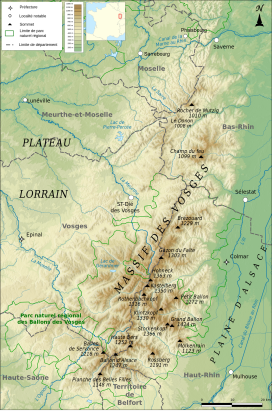Vosges Mountains
| Vosges | |
|---|---|

Location of the Vosges
|
|
| Highest point | |
| Peak | (Grand Ballon (Alsatian: Großer Belchen)) |
| Elevation | 1,424 m (4,672 ft) |
| Dimensions | |
| Length | 120 km (75 mi) |
| Area | 5,500 km2 (2,100 sq mi) up to 6,000 square kilometres (2,300 sq mi) depending on the natural region boundaries selected |
| Geography | |
| State | Alsace, Lorraine, Franche-Comté (France) |
| Range coordinates | 48°N 7°E / 48°N 7°ECoordinates: 48°N 7°E / 48°N 7°E |
| Geology | |
| Orogeny | Low mountain range |
| Age of rock |
Gneiss, granite and vulcanite stratigraphic units: about 419–252 MYA Bunter sandstone stratigraphic unit: 252–243 MYA |
| Type of rock | Gneiss, granite, vulcanite, sandstone |
Gneiss, granite and vulcanite stratigraphic units: about 419–252 MYA
The Vosges (French pronunciation: [voʒ]) (German: Vogesen [voˈɡeːzn̩]), also called the Vosges Mountains, are a range of low mountains in eastern France, near its border with Germany. Together with the Palatine Forest to the north on the German side of the border, they form a single geomorphological unit and low mountain range of around 8,000 square kilometres (3,100 sq mi) in area. It runs in a north-northeast direction from the Burgundian Gate (the Belfort–Ronchamp–Lure line) to the Börrstadt Basin (the Winnweiler–Börrstadt–Göllheim line), and forms the western boundary of the Upper Rhine Plain.
The Grand Ballon is the highest peak at 1424 m, followed by the Storkenkopf (1366 m), and the Hohneck (1364 m).
The elongated massif is divided south to north into three sections:
In addition, the term "Central Vosges" is used to designate the various lines of summits, especially those above 1000 metres in elevation. The French department of Vosges is named after the range.
From a geological point of view, a graben at the beginning of the Paleogene Period caused the formation of Alsace and the uplift of the plates of the Vosges, now considered in eastern France, and those in the Black Forest, now in Germany. From a scientific view, the Vosges Mountains are not mountains as such, but rather the western edge of the unfinished Alsatian graben, stretching continuously as part of the larger Tertiary formations. Erosive glacial action was the primary catalyst for development of the representative highland massif feature.
...
Wikipedia

